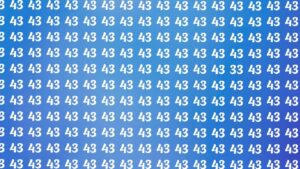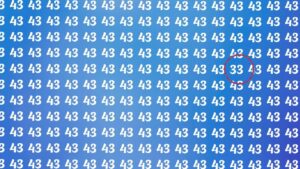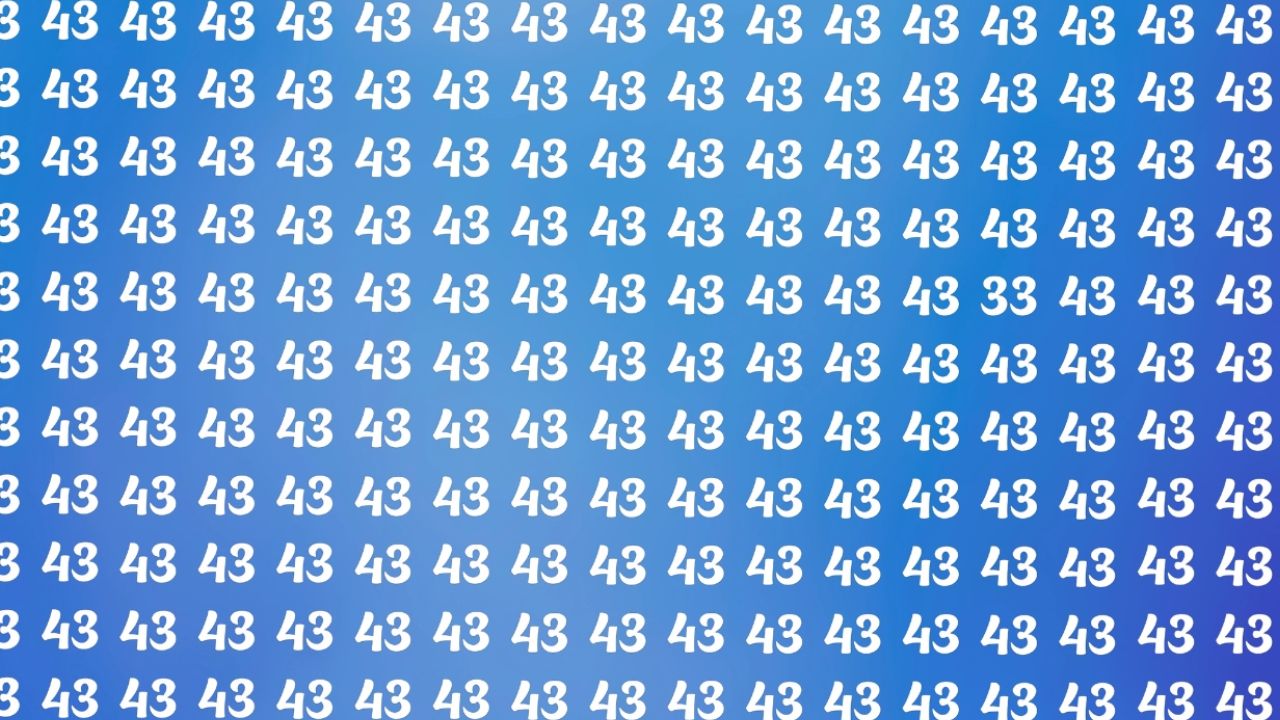Have you ever stared at an image for minutes, desperately searching for something that seems impossible to find? Welcome to the captivating realm of visual perception, where a simple optical illusion can humble even the sharpest minds. Today, we’re diving deep into one of the internet’s most challenging puzzles: finding the elusive number 34 hidden within a complex visual design.
What Makes This Optical Illusion So Challenging?
The number 34 optical illusion has become a viral sensation across social media platforms, leaving millions of viewers scratching their heads in frustration. Unlike traditional hidden object puzzles, this particular visual challenge exploits fundamental weaknesses in human perception, making it extraordinarily difficult for our brains to process the embedded information correctly.

When you first encounter this optical illusion, your eyes immediately begin scanning the image in predictable patterns. Most people start from the top-left corner and work their way across and down – a reading pattern ingrained from childhood. However, the designers of this puzzle deliberately placed the number 34 in locations that contradict these natural eye movements.
The Science Behind Visual Perception
Our brains process visual information through complex neural pathways that have evolved over millions of years. These pathways are incredibly efficient at recognizing patterns, faces, and potential threats, but they can be easily fooled by cleverly designed illusions. The number 34 optical illusion exploits several key aspects of human vision:
Selective Attention: Your brain filters out information it deems irrelevant, sometimes hiding the very thing you’re looking for. When searching for specific numbers, your mind creates a mental template of what “34” should look like, potentially causing you to overlook variations in font, size, or orientation.
Gestalt Principles: These psychological principles explain how we perceive whole objects rather than individual components. In this optical illusion, the number 34 might be camouflaged within larger patterns that your brain interprets as single, unified shapes rather than collections of individual elements.
Different Types of Number-Hiding Techniques
The creators of viral optical illusion puzzles employ various sophisticated techniques to conceal numbers like 34 within their designs. Understanding these methods can significantly improve your puzzle-solving abilities and help you appreciate the artistry behind these brain teasers.
Color Camouflage Methods
One of the most effective hiding techniques involves using colors that are nearly identical to the background. The number 34 might be rendered in a shade that’s only slightly different from its surroundings, making it virtually invisible to casual observation. This optical illusion technique exploits the limitations of human color perception, particularly in environments with poor lighting or on low-quality displays.
Pattern Integration Strategies
Advanced optical illusion designers seamlessly integrate hidden numbers into complex background patterns. The number 34 could be formed by the negative space between decorative elements, or it might be constructed from pattern components that serve dual purposes. This technique requires viewers to shift their perception and look beyond the obvious foreground elements.
Size and Scale Manipulation
Sometimes the number 34 is hidden in plain sight, but at an unexpected size. It might be enormous, spanning the entire width of the image, or microscopic, requiring viewers to examine fine details closely. This optical illusion approach challenges our assumptions about how hidden objects should appear.
Proven Strategies for Finding Hidden Numbers
If you’re determined to crack the number 34 optical illusion, these scientifically-backed strategies can dramatically improve your success rate. Professional puzzle solvers and cognitive researchers have identified several reliable techniques for overcoming visual perception challenges.
The Systematic Grid Method
Divide the image into a mental grid of nine equal sections. Examine each section individually for 15-20 seconds, resisting the urge to let your eyes wander to other areas. This methodical approach ensures comprehensive coverage and prevents your brain from repeatedly scanning the same areas while ignoring others.
Distance and Angle Variation
Step back from your screen or hold your device at arm’s length. Sometimes the number 34 becomes visible only when viewed from specific distances or angles. This optical illusion technique exploits the way our eyes focus and process spatial relationships at different scales.
Color Filtering Techniques
Try viewing the image through colored filters or by adjusting your device’s color settings. Some hidden numbers become apparent when certain color channels are emphasized or suppressed. While this might seem like cheating, it’s actually a legitimate problem-solving strategy used by professionals in various fields.
The Psychology of Frustration and Persistence
Why do people become so obsessed with solving a single optical illusion? The answer lies in the psychological concept of the “Zeigarnik Effect” – our brains’ tendency to remember incomplete tasks more vividly than completed ones. When you can’t find the number 34, your mind creates a persistent mental itch that demands scratching.
This psychological response explains why viral visual puzzles spread so rapidly across social media. People share these challenges not just for entertainment, but to alleviate their own cognitive frustration by involving others in the search process.
When to Take a Break
Cognitive scientists recommend taking regular breaks when working on challenging optical illusion puzzles. After 10-15 minutes of concentrated searching, your brain begins to develop “search blindness” – a state where continued effort actually decreases your chances of success. A brief mental reset can restore your perceptual flexibility and reveal previously hidden details.
Historical Context of Number-Based Optical Illusions
The tradition of hiding numbers and symbols within complex imagery dates back centuries, long before the digital age transformed these puzzles into viral sensations. Medieval artists often embedded religious symbols and numbers into their paintings, while Renaissance masters used similar techniques to include hidden signatures and dates.
The modern number 34 optical illusion phenomenon represents the evolution of these classical techniques, enhanced by digital design tools and optimized for social media sharing. Contemporary puzzle creators can manipulate colors, patterns, and layouts with unprecedented precision, creating challenges that would have been impossible to produce manually.
Cultural Significance of Number Puzzles
Different cultures have developed unique approaches to number-based visual puzzles. Asian puzzle traditions, particularly those from Japan and China, emphasize harmony between hidden elements and overall design aesthetics. Western optical illusion creators often prioritize maximum difficulty and viral potential over artistic balance.
Neurological Benefits of Solving Visual Puzzles
Regular engagement with optical illusion challenges like the number 34 puzzle provides measurable cognitive benefits. Neuroscientists have documented improvements in visual processing speed, attention span, and pattern recognition abilities among people who regularly solve these types of puzzles.
The act of searching for hidden numbers exercises the same neural pathways used in critical real-world skills like reading, driving, and problem-solving. This makes visual puzzle-solving not just entertaining but genuinely beneficial for maintaining cognitive health throughout life.
Training Your Visual System
Professional pilots, surgeons, and security personnel often use sophisticated visual training programs that share fundamental similarities with popular optical illusion puzzles. These programs improve practitioners’ ability to detect small changes, identify relevant details in complex environments, and maintain focus during extended periods of visual concentration.

The Future of Interactive Visual Challenges
As technology continues advancing, the humble number 34 optical illusion represents just the beginning of increasingly sophisticated visual challenges. Virtual reality and augmented reality platforms are already experimenting with three-dimensional hidden object puzzles that respond to head movements and eye tracking.
Machine learning algorithms are being developed to create personalized visual challenges that adapt to individual viewers’ strengths and weaknesses. These future puzzles might adjust their difficulty in real-time, ensuring optimal challenge levels for maximum engagement and cognitive benefit.
The simple act of searching for a hidden number has evolved into a complex intersection of art, science, and technology, proving that even the most basic human activities can reveal profound insights about perception, cognition, and the remarkable capabilities of the human brain.
Frequently Asked Questions
Q: How long should I spend looking for the number 34 before giving up? A: Cognitive experts recommend spending no more than 15 minutes on a single optical illusion session. Take breaks and return with fresh eyes for better results.
Q: Are there any tricks to make finding hidden numbers easier? A: Yes! Try squinting, changing your viewing distance, adjusting screen brightness, or looking at the image upside-down. These techniques can reveal hidden patterns.
Q: Why can some people find hidden numbers immediately while others struggle? A: Individual differences in visual processing, attention patterns, and previous puzzle experience all contribute to varying performance levels on optical illusions.
Q: Do optical illusions work the same way for everyone? A: No, factors like age, visual acuity, cultural background, and neurological differences can significantly affect how people perceive optical illusions.
Q: Can solving optical illusions improve my vision? A: While they won’t correct vision problems, regular puzzle-solving can enhance visual processing skills, attention to detail, and pattern recognition abilities.
